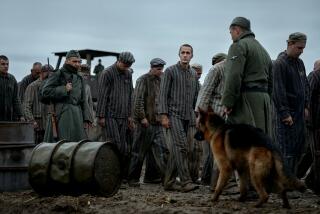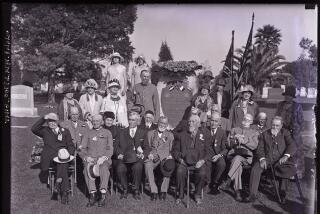Views From the Camps : Contrasting Images of WWII Internment
It was autumn, 1943, and Ansel Adams was shooting images of Manzanar, one of 10 U.S internment camps for Japanese-Americans during World War II. Walking through Los Angeles-born Michael Yonemitsuâs barracks-style housing, Adams came upon a snapshot of Yonemitsuâs brother, Robert, in his U.S. Army uniform. Alongside the photo were some of the soldierâs letters home. Adams took a picture.
Adamsâ photograph at the Yonemitsuâs links two photography exhibitions opening today at UCLAâs Wight Art Gallery. The first show features 40 government-approved photographs by Adams which were shot and exhibited at Manzanar in the â40s. But the Yonemitsu photo is exhibited around the corner in âExecutive Order 9066: The Internment of 110,000 Japanese Americans,â a much harsher look at that period.
The two shows contrast images from the same shameful historical time. Internees lost their houses and farms, their livelihoods and their freedom, and were transported from their homes to inhospitable, often primitive camps in the middle of nowhere. Nobody was formally charged with any crime, and two-thirds of the people interned were native-born Americans. At the same time that thousands of Japanese-Americans were serving in the war, their parents and families were being shunted into the internment camps.
Adams captures the stillness of the Owens Valley that surrounds Manzanar--a California town whose name means apple orchard in Spanish--and often frames his photo subjects with western clouds or mountains familiar to skiers. The 65 photographs in âExecutive Order 9066,â first mounted by the California Historical Society in 1972, record the closed stores and hurried departures, the anti-Japanese sentiment of former neighbors, the desolation and humiliation of life in the camps.
The Wight exhibitions help launch a year of events at UCLA and throughout Los Angeles commemorating the 50th anniversary of Executive Order 9066, the internment order signed into law on Feb. 19, 1942, by President Franklin D. Roosevelt 10 weeks after the bombing of Pearl Harbor. Events throughout the city today will make up a Day of Remembrance noting the historical importance of the massive wartime internment.
Recent waves of Japan-bashing are not the only reason the exhibitions are particularly relevant these days. Americaâs âunwarranted conclusionsâ about dual loyalties are hardly limited to Japanese-Americans, suggests Don Nakanishi, director of UCLAâS Asian American Studies Center, a co-sponsor of the exhibitions.
Noting, for instance, the ties of American Jews to Israel or Chinese-Americans to China, Nakanishi points to âthe early stages of suspicionâ and incipient âhysteriaâ involving Arab-Americans during last yearâs Persian Gulf War.
The showâs bid for universality starts with the âWar Relocation Centerâ replica straddling its entrance. Framed UCLA student newspapers from the early 1940s bring home the immediacy of the internment, reporting how Japanese students and others were banned from both Westwood Village and campus.
For the Adams exhibition, Nakanishi and gallery curator Elizabeth Shepherd selected photos from a collection donated to the campusâs University Research Library by Ralph Merritt, Manzanarâs second administrator (and later a regent of the University of California), who invited the famed photographer to the camp. Adams wrote later that he was âmoved by the human story unfolding in the encirclement of desert and mountains, and by the wish to identify my photography in some creative way with the tragic momentum of the times.â
Photos in the exhibition are primarily classic Adams images, often beautiful landscapes with startling skies. They capture people at work and at home, in church or at supper. As Shepherd explains, Adamsâ idealistic photographs tended to emphasize internee attempts âto establish normalcy in their lives.â
âIf you looked at just those photos, youâd come away with the idea that these camps were nothing more than small-town America of that period,â says UCLA scholar Yuji Ichioka, an ex-internment camp resident and a consultant to the show. âThere is not one picture of barbed wire or of a guard tower. Everybody appears to be well-dressed, well-fed and smiling. There is nothing dark or negative.â
Adams did more editorializing in his prose, writing first a pamphlet and later a book called âBorn Free and Equalâ which accompanied his photographs. There the photographer questioned the âdangerâ that the internees presented to America, hoping that their treatment after the war would be more decent. And his closing sentence, penned in August, 1944, at Manzanar, was that given the importance of individual rights, Americans can not âallow passion, vengeance, hatred and racial antagonism to cloud the principles of universal justice and mercy.â
Such sentiments hardly fared well with a 1944 audience, and Nakanishi says Adamsâs words and images were âhighly controversialâ at the time. The general public didnât much want to look at sympathetic photos or hear about the kindly internees Adams called âperfectly loyal American citizens.â Copies of âBorn Free and Equalâ were burned in protest.
âExecutive Order 9066â wasnât particularly popular when it first emerged in 1972, either. It was curated by Maisie and Richard Conrat--the latter had worked as an assistant to Dorothea Lange, whose photographs represent about a third of those in the show--who sorted through about 25,000 photographs to come up with 100 which they felt worked as both historical documents and images. Even the Conrats worried at the time âthat focusing public attention on the evacuation of Japanese-Americans (might be viewed) as somewhat unpatriotic.â
The images by Lange and others do not show America at its best. Internees are herded across a bridge by armed soldiers or confront palpable prejudice. A sign propped up on a barberâs cash register reads: âWe donât want any Japs back here--ever.â
Interspersed among the photographs are textual blowups of chilling commentary from newspapers and other sources. A citation from the Dec. 6, 1943, edition of the Yuma Sun and Sentinel, for instance, cites a Los Angeles Times poll that found Southern Californians voting 14 to 1 in favor of deportation of all Japanese from the United States and a ban on further Japanese immigration.
âExecutive Order 9066â was at the former Pasadena Art Museum for six weeks in spring, 1972--when one TV broadcast about it drew 55 hate calls in 10 minutes--as part of a national tour. Nakanishi did not see the show but says its catalogue was extremely important in teaching him about that period. The 42-year-old third-generation Japanese-American says both the show and catalogue represented the first time he and many other young Japanese-Americans âfirst came to grips about this experience.â
Nakanishiâs parents were sent from their home in East Los Angeles to a camp in Poston, Ariz., he says, and his wifeâs family was at Manzanar. But, he says, âmy folks, like other Japanese-American parents, didnât tell us a whole lot about their internment experience. . . . They (and others) rarely talked about how victimized they were by this humiliating and tragic episode.â
Look at a framed page from the California Daily Bruin of April 23, 1942, he suggests, where a photograph freezes two students looking at a government edict posted in Westwood Village which bans all people of Japanese ancestry from the local area. âThose of my generation see posters of this (edict) and think it is an abstract historical document,â Nakanishi says. âSo to see a couple of students reading it in Westwood really brings it close to home.â
Future events here should do the same. UCLA has scheduled a ceremony next Saturday which includes participation of about 20 of the 175 UCLA students whose educations at the university were cut off by internment. Assorted seminars as well as a film festival, plays and musical events about the internment follow later in the year. And scheduled at the Wight Art Gallery from Oct. 11 through Dec. 6 will be a major national exhibition of paintings, sculpture and other artworks produced in the internment camps.
Meanwhile, visitors to the dual photography show will be able to buy copies of the original âExecutive Order 9066â catalogue, out of print for 20 years, or read through stacks of student newspapers from the internment period. The wartime California Daily Bruins show that âit happened right here in Westwood,â says curator Shepherd. âWe call attention to these events through our exhibition (with hopes) it wonât happen again.â
More to Read
The biggest entertainment stories
Get our big stories about Hollywood, film, television, music, arts, culture and more right in your inbox as soon as they publish.
You may occasionally receive promotional content from the Los Angeles Times.










